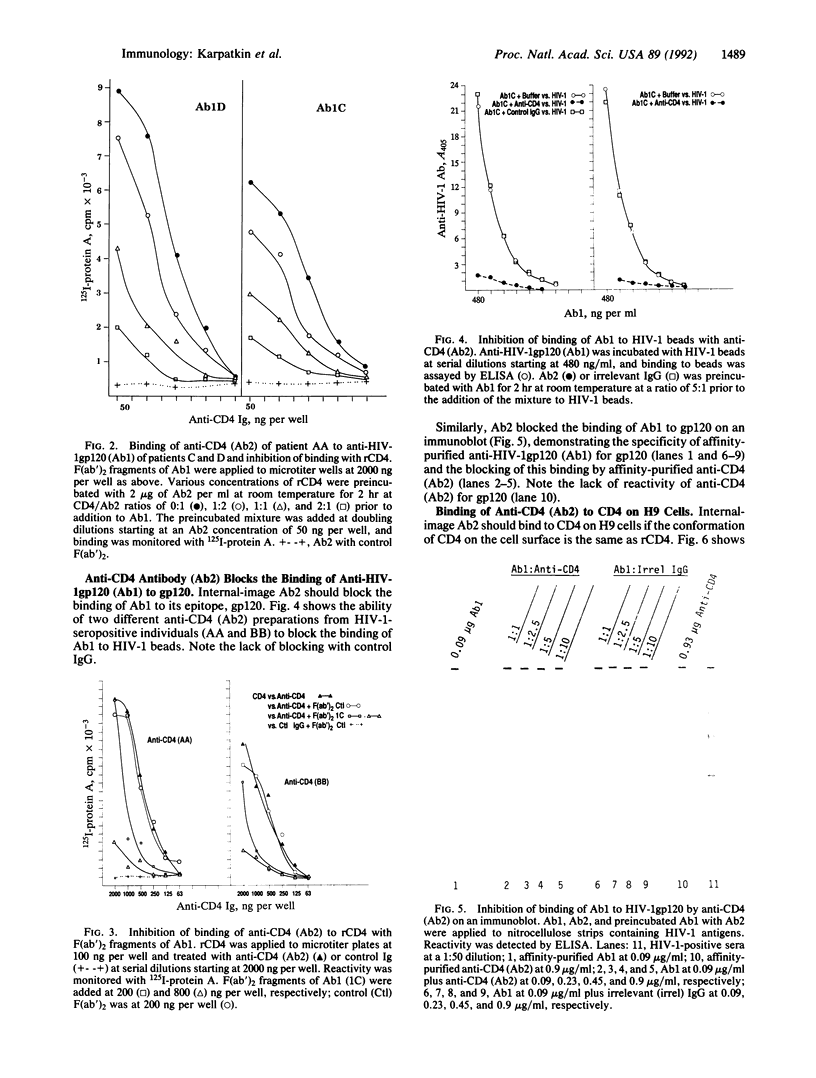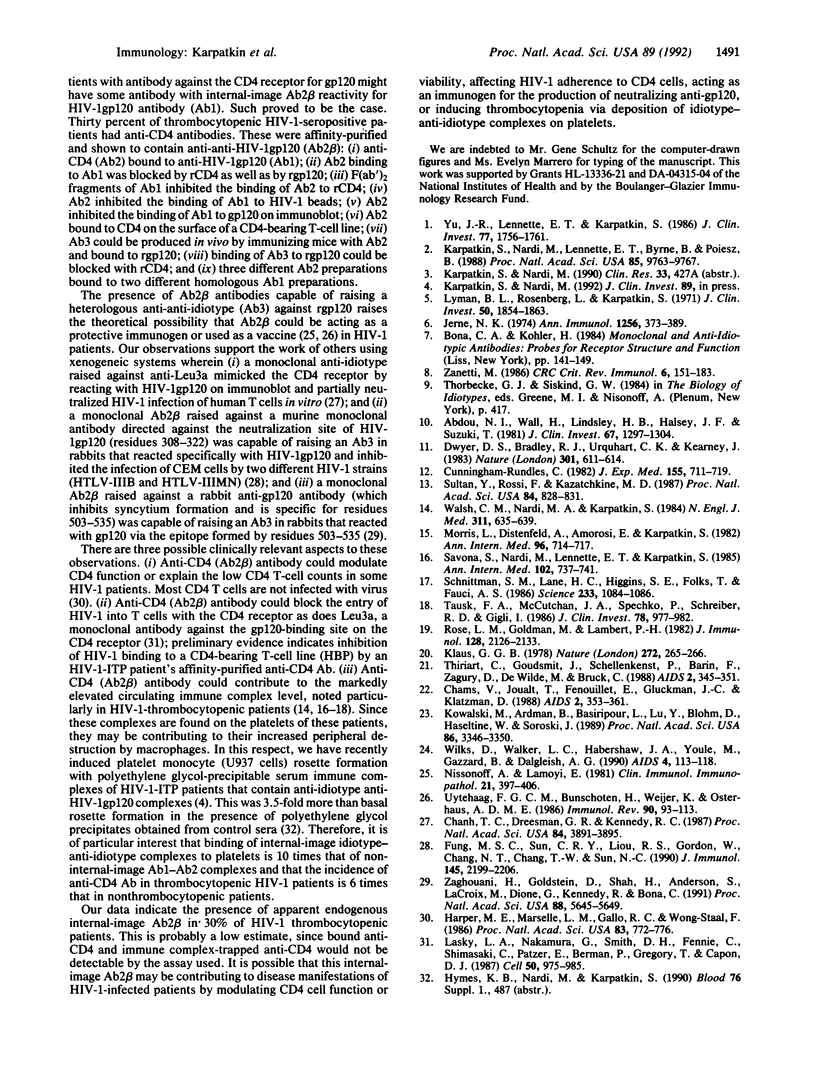Abstract
Anti-CD4 antibody was found in 30% of human immunodeficiency virus (HIV-1)-seropositive thrombocytopenic patients compared with 5% of nonthrombocytopenic seropositive patients (chi 2 = 21.7, P less than 0.001) and was shown by the following observations to contain internal-image anti-idiotype antibody (Ab2) directed against the antibody (Ab1) to gp120, the HIV-1 envelope glycoprotein that binds to CD4: (i) affinity-purified anti-CD4 (Ab2) bound to affinity-purified anti-HIV-1gp120 (Ab1) on solid-phase radioimmunoassay, and binding could be blocked by recombinant CD4 (rCD4) as well as recombinant gp120 (rgp120); (ii) F(ab')2 fragments of Ab1 inhibited the binding of Ab2 to rCD4; (iii) Ab2 inhibited the binding of Ab1 to HIV-1 beads; (iv) Ab2 inhibited the binding of Ab1 to gp120 on immunoblot; (v) Ab2 bound to the CD4 receptor on a CD4-bearing T-cell line, H9; (vi) Ab3 (anti-rgp120) could be produced in vivo by immunizing mice with Ab2, and binding of Ab3 to rgp120 could be blocked with rCD4; and (vii) three different Ab2 preparations bound to two different homologous Ab1 preparations. Ab1 or Ab2 alone did not bind to platelets, whereas the idiotype-anti-idiotype complex did bind to platelets in a concentration-dependent manner. Binding of the internal-image complex was 10-fold greater than that of a non-internal-image Ab1-Ab2 complex composed of anti-HIV-1gp120 and anti-anti-HIV-1gp120. Thus, patients with HIV-1 thrombocytopenia contain internal-image idiotype-anti-idiotype complexes that could be affecting CD4 cell number or function, inhibiting HIV-1 binding to CD4 cells or contributing to HIV-1 thrombocytopenia.
Full text
PDF




Images in this article
Selected References
These references are in PubMed. This may not be the complete list of references from this article.
- Abdou N. I., Wall H., Lindsley H. B., Halsey J. F., Suzuki T. Network theory in autoimmunity. In vitro suppression of serum anti-DNA antibody binding to DNA by anti-idiotypic antibody in systemic lupus erythematosus. J Clin Invest. 1981 May;67(5):1297–1304. doi: 10.1172/JCI110158. [DOI] [PMC free article] [PubMed] [Google Scholar]
- Chams V., Jouault T., Fenouillet E., Gluckman J. C., Klatzmann D. Detection of anti-CD4 autoantibodies in the sera of HIV-infected patients using recombinant soluble CD4 molecules. AIDS. 1988 Oct;2(5):353–361. doi: 10.1097/00002030-198810000-00004. [DOI] [PubMed] [Google Scholar]
- Chanh T. C., Dreesman G. R., Kennedy R. C. Monoclonal anti-idiotypic antibody mimics the CD4 receptor and binds human immunodeficiency virus. Proc Natl Acad Sci U S A. 1987 Jun;84(11):3891–3895. doi: 10.1073/pnas.84.11.3891. [DOI] [PMC free article] [PubMed] [Google Scholar]
- Cunningham-Rundles C. Naturally occurring autologous anti-idiotypic antibodies. Participation in immune complex formation in selective IgA deficiency. J Exp Med. 1982 Mar 1;155(3):711–719. doi: 10.1084/jem.155.3.711. [DOI] [PMC free article] [PubMed] [Google Scholar]
- Dwyer D. S., Bradley R. J., Urquhart C. K., Kearney J. F. Naturally occurring anti-idiotypic antibodies in myasthenia gravis patients. Nature. 1983 Feb 17;301(5901):611–614. doi: 10.1038/301611a0. [DOI] [PubMed] [Google Scholar]
- Fung M. S., Sun C. R., Liou R. S., Gordon W., Chang N. T., Chang T. W., Sun N. C. Monoclonal anti-idiotypic antibody mimicking the principal neutralization site in HIV-1 GP120 induces HIV-1 neutralizing antibodies in rabbits. J Immunol. 1990 Oct 1;145(7):2199–2206. [PubMed] [Google Scholar]
- Harper M. E., Marselle L. M., Gallo R. C., Wong-Staal F. Detection of lymphocytes expressing human T-lymphotropic virus type III in lymph nodes and peripheral blood from infected individuals by in situ hybridization. Proc Natl Acad Sci U S A. 1986 Feb;83(3):772–776. doi: 10.1073/pnas.83.3.772. [DOI] [PMC free article] [PubMed] [Google Scholar]
- Jerne N. K. Towards a network theory of the immune system. Ann Immunol (Paris) 1974 Jan;125C(1-2):373–389. [PubMed] [Google Scholar]
- Karpatkin S., Nardi M., Lennette E. T., Byrne B., Poiesz B. Anti-human immunodeficiency virus type 1 antibody complexes on platelets of seropositive thrombocytopenic homosexuals and narcotic addicts. Proc Natl Acad Sci U S A. 1988 Dec;85(24):9763–9767. doi: 10.1073/pnas.85.24.9763. [DOI] [PMC free article] [PubMed] [Google Scholar]
- Klaus G. G. Antigen-antibody complexes elicit anti-idiotypic antibodies to self-idiotopes. Nature. 1978 Mar 16;272(5650):265–266. doi: 10.1038/272265a0. [DOI] [PubMed] [Google Scholar]
- Kowalski M., Ardman B., Basiripour L., Lu Y. C., Blohm D., Haseltine W., Sodroski J. Antibodies to CD4 in individuals infected with human immunodeficiency virus type 1. Proc Natl Acad Sci U S A. 1989 May;86(9):3346–3350. doi: 10.1073/pnas.86.9.3346. [DOI] [PMC free article] [PubMed] [Google Scholar]
- Lasky L. A., Nakamura G., Smith D. H., Fennie C., Shimasaki C., Patzer E., Berman P., Gregory T., Capon D. J. Delineation of a region of the human immunodeficiency virus type 1 gp120 glycoprotein critical for interaction with the CD4 receptor. Cell. 1987 Sep 11;50(6):975–985. doi: 10.1016/0092-8674(87)90524-1. [DOI] [PubMed] [Google Scholar]
- Lyman B., Rosenberg L., Karpatkin S. Biochemical and biophysical aspects of human platelet adhesion to collagen fibers. J Clin Invest. 1971 Sep;50(9):1854–1863. doi: 10.1172/JCI106677. [DOI] [PMC free article] [PubMed] [Google Scholar]
- Morris L., Distenfeld A., Amorosi E., Karpatkin S. Autoimmune thrombocytopenic purpura in homosexual men. Ann Intern Med. 1982 Jun;96(6 Pt 1):714–717. doi: 10.7326/0003-4819-96-6-714. [DOI] [PubMed] [Google Scholar]
- Nisonoff A., Lamoyi E. Implications of the presence of an internal image of the antigen in anti-idiotypic antibodies: possible application to vaccine production. Clin Immunol Immunopathol. 1981 Dec;21(3):397–406. doi: 10.1016/0090-1229(81)90228-2. [DOI] [PubMed] [Google Scholar]
- Rose L. M., Goldman M., Lambert P. H. The production of anti-idiotypic antibodies and of idiotype-anti-idiotype immune complexes after polyclonal activation induced by bacterial LPS. J Immunol. 1982 May;128(5):2126–2133. [PubMed] [Google Scholar]
- Savona S., Nardi M. A., Lennette E. T., Karpatkin S. Thrombocytopenic purpura in narcotics addicts. Ann Intern Med. 1985 Jun;102(6):737–741. doi: 10.7326/0003-4819-102-6-737. [DOI] [PubMed] [Google Scholar]
- Schnittman S. M., Lane H. C., Higgins S. E., Folks T., Fauci A. S. Direct polyclonal activation of human B lymphocytes by the acquired immune deficiency syndrome virus. Science. 1986 Sep 5;233(4768):1084–1086. doi: 10.1126/science.3016902. [DOI] [PubMed] [Google Scholar]
- Sultan Y., Rossi F., Kazatchkine M. D. Recovery from anti-VIII:C (antihemophilic factor) autoimmune disease is dependent on generation of antiidiotypes against anti-VIII:C autoantibodies. Proc Natl Acad Sci U S A. 1987 Feb;84(3):828–831. doi: 10.1073/pnas.84.3.828. [DOI] [PMC free article] [PubMed] [Google Scholar]
- Tausk F. A., McCutchan A., Spechko P., Schreiber R. D., Gigli I. Altered erythrocyte C3b receptor expression, immune complexes, and complement activation in homosexual men in varying risk groups for acquired immune deficiency syndrome. J Clin Invest. 1986 Oct;78(4):977–982. doi: 10.1172/JCI112688. [DOI] [PMC free article] [PubMed] [Google Scholar]
- Thiriart C., Goudsmit J., Schellekens P., Barin F., Zagury D., De Wilde M., Bruck C. Antibodies to soluble CD4 in HIV-1-infected individuals. AIDS. 1988 Oct;2(5):345–351. doi: 10.1097/00002030-198810000-00003. [DOI] [PubMed] [Google Scholar]
- UytdeHaag F. G., Bunschoten H., Weijer K., Osterhaus A. D. From Jenner to Jerne: towards idiotype vaccines. Immunol Rev. 1986 Apr;90:93–113. doi: 10.1111/j.1600-065x.1986.tb01479.x. [DOI] [PubMed] [Google Scholar]
- Walsh C. M., Nardi M. A., Karpatkin S. On the mechanism of thrombocytopenic purpura in sexually active homosexual men. N Engl J Med. 1984 Sep 6;311(10):635–639. doi: 10.1056/NEJM198409063111004. [DOI] [PubMed] [Google Scholar]
- Wilks D., Walker L. C., Habeshaw J. A., Youle M., Gazzard B., Dalgleish A. G. Anti-CD4 autoantibodies and screening for anti-idiotypic antibodies to anti-CD4 monoclonal antibodies in HIV-seropositive people. AIDS. 1990 Feb;4(2):113–118. doi: 10.1097/00002030-199002000-00003. [DOI] [PubMed] [Google Scholar]
- Yu J. R., Lennette E. T., Karpatkin S. Anti-F(ab')2 antibodies in thrombocytopenic patients at risk for acquired immunodeficiency syndrome. J Clin Invest. 1986 Jun;77(6):1756–1761. doi: 10.1172/JCI112498. [DOI] [PMC free article] [PubMed] [Google Scholar]
- Zaghouani H., Goldstein D., Shah H., Anderson S., Lacroix M., Dionne G., Kennedy R., Bona C. Induction of antibodies to the envelope protein of the human immunodeficiency virus by immunization with monoclonal anti-idiotypes. Proc Natl Acad Sci U S A. 1991 Jul 1;88(13):5645–5649. doi: 10.1073/pnas.88.13.5645. [DOI] [PMC free article] [PubMed] [Google Scholar]
- Zanetti M. Idiotypic regulation of autoantibody production. Crit Rev Immunol. 1986;6(2):151–183. [PubMed] [Google Scholar]



